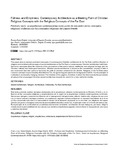Mostrar o rexistro simple do ítem
Fullness and Emptiness. Contemporary Architecture as a Meeting Point of Christian Religious Concepts with the Religious Concepts of the Far East
| dc.contributor.author | Sokol Gojnik, Zorana | |
| dc.contributor.author | Gojnik, Igor | |
| dc.date.accessioned | 2022-03-28T12:47:13Z | |
| dc.date.available | 2022-03-28T12:47:13Z | |
| dc.date.issued | 2021-12-15 | |
| dc.identifier.citation | Sokol-Gojnik, Z., & Gojnik, I. (2021). Fullness and Emptiness: Contemporary Architecture as a Meeting Point of Christian Religious Concepts with the Religious Concepts of the Far East. Actas de Arquitectura Religiosa Contemporánea, 8, 78-89. https://doi.org/10.17979/aarc.2021.8.0.8842 | es_ES |
| dc.identifier.issn | 2659-8671 | |
| dc.identifier.uri | http://hdl.handle.net/2183/30285 | |
| dc.description.abstract | [Abstract] This paper aims to analyze prominent examples of contemporary Christian architecture in the Far East, and the influence of religious and architectural concepts of sacred architecture of the Far East on contemporary Christian architecture built there. Numerous examples show the influence of the permeation of that area’s cultural, traditional, and religious heritage with the Christian cultural and theological framework. Christian sacred architecture is based on the monotheistic concept of faith in one incarnated God that opens to humanity the path to salvation achieved in the afterlife. Religions of the Far East share common concepts of proccesuality described as Tao, the governing principle in the background of all life. It is the principle of continuity in an eternally changing universe. The intention of this paper is, therefore, to direct the view towards the permeation of cultures that encourages Christian sacred architecture towards the search for a new, authentic identity. | es_ES |
| dc.description.abstract | [Resumen] Este texto pretende analizar ejemplos destacados de la arquitectura cristiana contemporánea en Extremo Oriente, y la influencia de los conceptos religiosos y arquitectónicos de la región en la arquitectura cristiana contemporánea construida. Numerosos ejemplos muestran la influencia de la impregnación del patrimonio cultural, tradicional y religioso de esa zona con el marco cultural y teológico cristiano. La arquitectura sagrada cristiana se basa en el concepto monoteísta de la fe en un Dios encarnado que abre a la humanidad el camino de la salvación alcanzada en la otra vida. Las religiones del Lejano Oriente comparten conceptos comunes de procesualidad descritos como Tao, el principio rector en el fondo de toda la vida. Es el principio de la continuidad en un universo eternamente cambiante. La intención de este trabajo es, por tanto, dirigir la mirada hacia la permeabilidad de las culturas que alienta la arquitectura sagrada cristiana hacia la búsqueda de una nueva y auténtica identidad. | es_ES |
| dc.language.iso | eng | es_ES |
| dc.publisher | Universidade da Coruña | es_ES |
| dc.relation.uri | https://doi.org/10.17979/aarc.2021.8.0.8842 | es_ES |
| dc.rights | Atribución-NoComercial-CompartirIgual 4.0 Internacional (CC BY-NC-SA 4.0) | es_ES |
| dc.rights.uri | https://creativecommons.org/licenses/by-nc-sa/4.0 | |
| dc.subject | Sacred Architecture | es_ES |
| dc.subject | Religion | es_ES |
| dc.subject | Architecture | es_ES |
| dc.subject | Christianity | es_ES |
| dc.subject | Far East Architecture | es_ES |
| dc.subject | Arquitectura religiosa | es_ES |
| dc.subject | Religión | es_ES |
| dc.subject | Arquitectura | es_ES |
| dc.subject | Cristianismo | es_ES |
| dc.subject | Arquitectura del Extremo Oriente | es_ES |
| dc.title | Fullness and Emptiness. Contemporary Architecture as a Meeting Point of Christian Religious Concepts with the Religious Concepts of the Far East | es_ES |
| dc.title.alternative | Plenitud y vacío. La arquitectura contemporánea como punto de encuentro de los conceptos religiosos cristianos con los conceptos religiosos del Lejano Oriente | es_ES |
| dc.type | info:eu-repo/semantics/conferenceObject | es_ES |
| dc.rights.access | info:eu-repo/semantics/openAccess | es_ES |
| dc.date.updated | 2022-03-25T13:23:49Z | |
| UDC.journalTitle | Actas de Arquitectura Religiosa Contemporánea | es_ES |
| UDC.volume | 8 | es_ES |
| UDC.startPage | 78 | es_ES |
| UDC.endPage | 89 | es_ES |
| dc.identifier.doi | 10.17979/aarc.2021.8.0.8842 |






